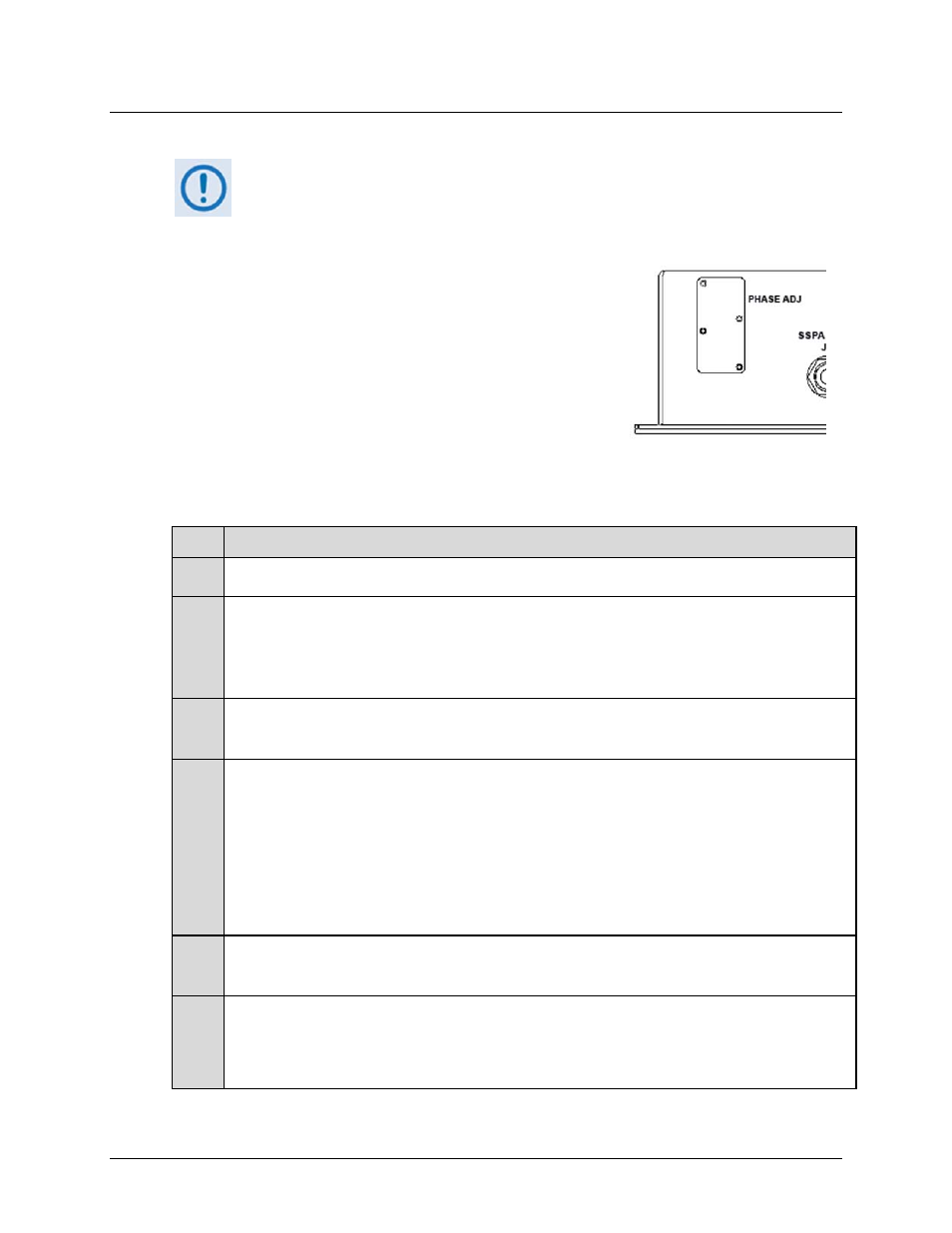6 phase alignment – Comtech EF Data PCB-4000 User Manual
Page 37

PCB-4000 1+1 Phase Combiner
Revision 2
Installation, Startup, and Troubleshooting Procedures
MN/PCB4000.IOM
3–9
3.6
Phase Alignment
As the system is aligned at the factory, this step should generally not be necessary
unless it has been required to replace one of the SSPAs or other critical path
components. Make sure to meet all parameters of Section 3.3 before performing
this adjustment.
This procedure assumes that the system installation is
complete and that the output port terminates in a
broadband high power load.
Verify the overall system performance by measuring the
ratio of the transmitted power to that of the power being
dissipated by the “dummy” load. If necessary, adjust the
phase balance by trimming the phase shifter, which is
located inside the PCCB box and accessible via a secured
cover labeled PHASE ADJ on the left side of the box.
Follow these steps:
Step Task
1
Ensure the system is set to 1+1 phase combined mode by issuing remote command RED=1 (see Chapter 5.
SERIAL REMOTE CONTROL).
2
A. Attach a power meter to the Combined Output Power Test Coupler (Figure 3-1).
B. Apply a low level signal at center frequency, making sure the output signal (at the system output port –
not the coupled port) will be at least 10 dB below Prated.
C. Measure the output power and include the coupler correction factor.
3
A. Attach a power meter to the Wasted (“Load”) Power Test Coupler (Figure 3-1).
B. Measure the power and include coupler correction factor.
4
If the Wasted (“Load”) power level is 15-20 dB below the transmitted power, the system is operating correctly.
However, if the ratio is below 10-15 dB, proceed to the align the phase shifter:
A. Remove the PHASE ADJ cover panel (Figure 3-5) located on the left side of the PCCB box.
B. Utilizing the supplied socket and screwdriver, first loosen the phase shifter lock nut.
C. Slowly adjust the phase shifter by turning the screwdriver. The system is aligned at the operating
frequency when the transmitted to “wasted” power ratio is maximized. If it is not possible to view
the transmitted and “wasted” power simultaneously, it is recommended to minimize the “wasted”
power. Generally, the “wasted” power reading will be more sensitive to phase shifter adjustments.
5
A. Achieve the desired operating output power by slowly increasing the input power.
B. Verify the appropriate ratio of the transmitted to dissipated power once more.
6
Verify that the system works over the full bandwidth by injecting a signal at the start and stop frequencies as
well. The ratio of the transmitted to “wasted” power should be 15-20 dB, but is not likely to be as good as it
was at the adjustment (center) frequency. If acceptable full bandwidth performance is not measured, it may
be necessary to repeat Steps 2 through 5 for the start, stop, and center frequencies – realizing that optimum
performance at any one particular frequency must be sacrificed slightly to achieve full bandwidth operation.
Figure 3-5. PCCB
PHASE ADJ Panel
